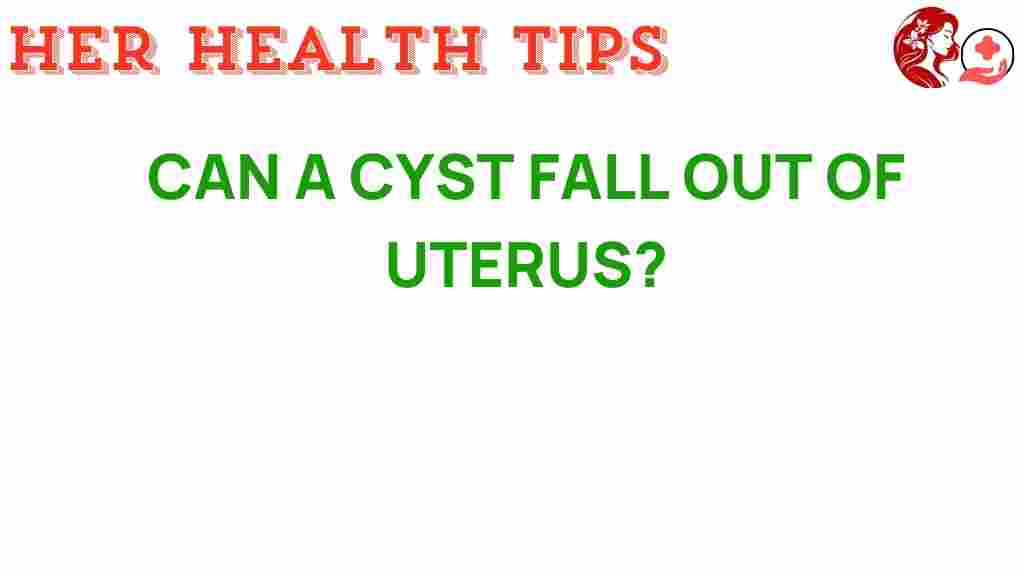The Surprising Truth: Can a Cyst Fall Out of the Uterus?
In the realm of women’s health, the topic of cysts, especially ovarian cysts, frequently arises. These fluid-filled sacs can become a source of concern for many women, leading to questions about their impact on reproductive health. One of the more surprising questions is whether a cyst can actually fall out of the uterus. In this article, we will explore this topic, debunk some medical myths, and provide an understanding of ovarian cysts, their symptoms, and treatment options.
Understanding Cysts and the Uterus
Cysts are common occurrences in women’s bodies and can form in various locations, including the ovaries and uterus. Understanding the anatomy involved is crucial in addressing concerns about cysts. The uterus is a hollow, muscular organ where a fetus develops during pregnancy, while cysts may develop in or on the ovaries, which are responsible for releasing eggs.
Before diving deeper, let’s clarify some common types of cysts associated with women’s reproductive health:
- Ovarian Cysts: These are fluid-filled sacs on the ovaries that can form during the menstrual cycle.
- Functional Cysts: These are the most common type and usually harmless, often resolving on their own.
- Dermoid Cysts: These can contain hair, fat, and other tissues and are generally benign.
- Endometriomas: These are linked to endometriosis and can cause pain and fertility issues.
Can a Cyst Fall Out of the Uterus?
The short answer to the question is: No, a cyst cannot “fall out” of the uterus in the way one might imagine. Cysts are typically contained within the ovaries or the lining of the uterus. However, the confusion may stem from the fact that cysts can rupture or become expelled, which can lead to significant discomfort and various symptoms.
Symptoms of Ovarian Cysts
Ovarian cysts can be asymptomatic, meaning they do not always produce noticeable symptoms. However, some women may experience:
- Pain during menstruation
- Pelvic pain before or during menstruation
- Pain during intercourse
- Unexplained weight gain
- Changes in menstrual cycle
- Nausea or vomiting, especially if a cyst ruptures
It is essential for women to be aware of these symptoms and seek medical attention if they experience severe pain or other concerning signs.
Medical Myths About Cysts
Many myths surround the topic of cysts and gynecology. Here are a few common misconceptions:
- Myth 1: All cysts are cancerous.
In reality, most cysts are benign and do not indicate cancer. - Myth 2: Cysts can be treated at home.
While some may resolve on their own, medical evaluation is essential for treatment. - Myth 3: Cysts are always painful.
Many women have cysts without experiencing any pain or symptoms.
Diagnosis of Ovarian Cysts
When a woman presents symptoms that may indicate the presence of a cyst, healthcare providers typically use a combination of methods to diagnose the condition:
- Pelvic Exam: A physical examination to check for any abnormalities.
- Ultrasound: This imaging test is commonly used to visualize cysts and assess their size and structure.
- Blood Tests: These may be conducted to check hormone levels and rule out cancer.
Treatment Options for Ovarian Cysts
The treatment for ovarian cysts depends on various factors, including the cyst type, size, and the woman’s symptoms and overall health. Common treatment approaches include:
- Watchful Waiting: Many functional cysts resolve on their own, and monitoring may be all that is needed.
- Medications: Hormonal contraceptives can help regulate the menstrual cycle and may prevent the formation of new cysts.
- Surgery: In cases where cysts are large, persistent, or causing complications, surgical intervention may be necessary.
Step-by-Step Process for Managing Ovarian Cysts
If you suspect you have an ovarian cyst, follow these steps:
- Consult Your Healthcare Provider: Schedule an appointment to discuss your symptoms.
- Undergo Diagnostic Tests: Allow your healthcare provider to perform the necessary exams and tests.
- Receive a Diagnosis: Understand what type of cyst you have and its implications.
- Discuss Treatment Options: Work with your provider to determine the best course of action.
- Follow Up: Schedule regular check-ups to monitor the cyst and your reproductive health.
Troubleshooting Tips for Managing Symptoms
While waiting for treatment or during management of ovarian cysts, you can take certain steps to alleviate symptoms:
- Heat Therapy: Applying a heating pad to the lower abdomen can help relieve menstrual pain.
- Over-the-Counter Pain Relief: Medications like ibuprofen or acetaminophen can help with discomfort.
- Dietary Adjustments: Maintaining a balanced diet rich in whole foods can support overall reproductive health.
- Regular Exercise: Gentle exercise may help alleviate symptoms and improve well-being.
Conclusion
In conclusion, while the idea of a cyst falling out of the uterus is a myth, understanding the nature of cysts and their impact on women’s reproductive health is essential. Ovarian cysts are common and usually benign, but they can cause discomfort and require medical attention. By being informed about symptoms, treatment options, and managing concerns, women can better navigate their reproductive health.
For more information on women’s health and gynecology, you can visit Women’s Health.gov for comprehensive resources and support. Remember to always consult with a healthcare professional regarding any health concerns.
Stay informed, stay healthy, and empower yourself with knowledge about your body!
This article is in the category Reproductive and created by HerHealthTips Team
